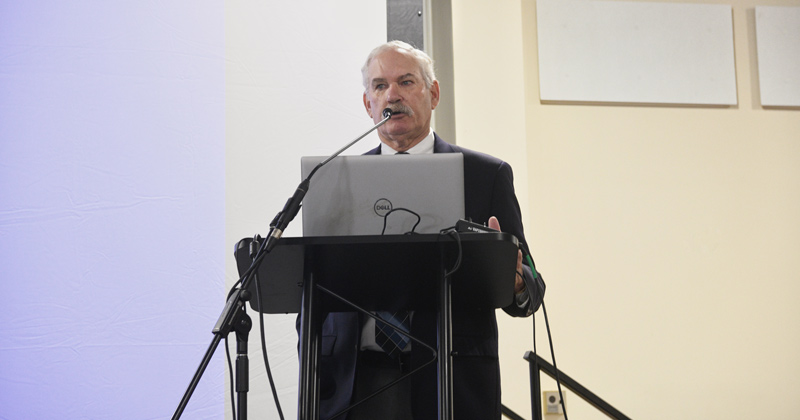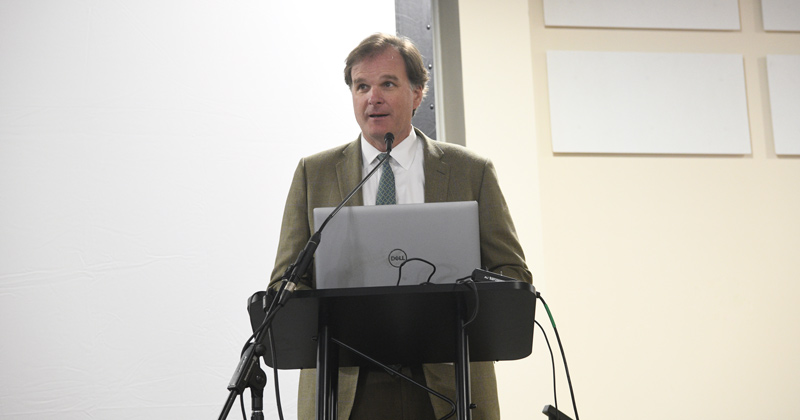


Clarity on carbon credits
March 14, 2023
UD College of Agriculture and Natural Resources holds first carbon symposium
The University of Delaware College of Agriculture and Natural Resources in partnership with the Delaware Department of Agriculture, hosted a Carbon Symposium on March 1, 2023 in Harrington. With wide variations of contracts and reward systems continually evolving, the first event’s goal was to clarify numerous questions farmers had about the carbon credit trading market.
More than 100 agricultural stakeholders attended to learn what carbon credits are and how the practice of no-till agriculture and planting cover crops sequester carbon in the soil — and therefore play a role in the carbon credit market. By incentivizing farmers to adopt sustainable practices, companies of all sizes and interests get closer to achieving their publicly made, carbon-neutral pledge to reduce greenhouse gas emissions by paying farmers to adopt sustainable practices.
Companies, corporations and industries approach their carbon-neutral goals differently. Many offset their carbon footprint by compensating farmers who add specific, sustainable approaches with their land. Both no-till agriculture, which does not disturb the soil and growing cover crops, which improves soil health by adding a blanket of organic material, are the most common and preferred practices. While many farmers already practice these sustainable methods, compensation in the carbon market arena must include new acreage, a condition known as ‘additionality.’ By practicing new sustainable techniques, farmers earn credits, which can be traded or sold. The overall goal is a significant reduction in greenhouse gasses worldwide.
In entering these carbon contracts, farmers also agree to share data so that carbon sequestration can be measured and verified.
Nate Bruce, UD extension specialist in farm business management, specialist, based at the UD Carvel Research and Education Center took the lead in assembling a panel that included perspectives from the local and federal Departments of Agriculture, legal and economic expertise, a soil health expert, long term sustainable strategies from the poultry industry and a perspective from a policy influencer in Washington, D.C.
“Carbon market programs present new opportunities for producers to earn additional income. Understanding the risks and rewards of navigating these programs is essential for anyone interested to become involved,” Bruce said.

Agriculture is uniquely suited to lead the way in reducing greenhouse gasses. The infrastructure and practices are often already in place, as are voluntary commitments from farmers, ranchers and foresters to be good caretakers of the land and environment
Keynote panelist Robert Bonnie, undersecretary of agriculture with the USDA, spent an hour on the evolution of attitudes and conversations that occurred across multiple administrations to incentivize farmers to reduce greenhouse gas emissions. His message was reassuring.
“Agriculture has a tremendous role to play in climate change,” said Bonnie. He said farmers were early adopters of innovation and change, such as nutrient management adoption, no-till crop production and improving soil health by growing cover crops. “Today, agriculture is only contributing 10-11% of the world’s greenhouse gas emissions,” Bonnie said.
“Our efficiency and adoption are already allowing us to use a smaller footprint,” Bonnie added.
Bonnie acknowledged regional differences in attitudes when the issue of climate policy is raised, particularly between rural and urban sectors. But when they surveyed attitudes across the board, everyone wanted the same thing — to practice good environmental stewardship.
“But there are differences in climate policy. The difference is not in the what – the differences are in the how,” Bonnie said.
Bonnie advocated a producer-led, voluntary approach in adopting climate policy, not a top-down government regulatory one. He noted that farmers, ranchers and foresters have a proven track record.
“US agriculture is good at this — good at efficiencies, technologies and innovation. So we should be good at the incorporation of carbon credit policy,” Bonnie added.
He stressed the importance of not only maintaining but adding productivity as an undeniable factor in the success of a carbon policy.
Bonnie announced that the recent passage of the Inflation Reduction Act is funding 141 keystone programs, built by and for agriculture producers.
“This is a learning network to create additional conservation and private sector investments in agriculture,” Bonnie said. “We’ve captured all of agriculture – grain, crops, livestock, dairy, forestry, underserved producers and small and medium farms.”
Shaping a successful climate policy needs broad incentives to depolarize difficult issues. Bonnie stressed the importance of bringing agriculture sectors to the table to shape policy. He concluded that climate policies will only work when there are incentives and collaboration that produce results, are built for and by farmers and demonstrate a benefit for agriculture. “It must be bipartisan and built for something that can last and be there for the long term,” Bonnie concluded.
The remainder of the symposium offered practical insights for farmers to understand the changing and fluid dynamics in the carbon credit trading markets. They heard legal considerations on contracts from Paul Goeringer, Extension specialist at the University of Maryland Cooperative Extension. An economist, Alejandro Pastina, from Iowa State University, shed additional light on the risks and benefits of the many pricing schemes involved with trading in carbon sequestration. Plastina introduced an online tool where farmers can enter their costs of inputs, additional acreage they want to convert and expected compensation rates from contracts or cost-sharing so they can anticipate the bottom line for their efforts before entering into carbon contracts.
The audience received a deep dive into soil chemistry from Charles White from Penn State University who reviewed how carbon is sequestered and the conditions that cause its release into the atmosphere. Two Perdue AgriBusiness representatives Drew Getty, vice president of environmental sustainability and regulatory affairs and Scott Raubenstine, vice president of agricultural services shared Perdue’s plans to offer additional incentives to growers beyond carbon sequestration. Zach Gihorski, director of government affairs and sustainability for the National Council of Farmer Cooperatives, wrapped up the event and spoke convincingly about the importance of farmer engagement across the board with trade associations, departments, suppliers and bipartisan involvement in order to shape policy and the 2023 Farm Bill.
“Prior to the symposium, I had a limited understanding of carbon credits and how they were utilized. This was my first more in-depth exposure,” said Don Clifton, a farmer near Milton in Sussex County. Clifton also serves as executive director for the Delaware Farm Bureau.”
“Much of the agronomy was somewhat familiar, but the discussion of soil structure included new things for me. The economics of how carbon credits currently come into play was mostly new material, as well as the legal aspects,” Clifton said. “There is more to learn. I think I speak for a lot of Delaware farmers when I say there is a lot more than we need to understand.”
Delaware Secretary of Agriculture Michael Scuse echoed the same sentiments. “At the end of the day, a lot of those who participated left with a lot more questions than maybe they came with because there's still a great deal of uncertainty, but the speakers did a really great job of explaining where we are today.”
Scuse said the symposium is an important first step with additional outreach to follow.
“As more and more information becomes available, there'll be an opportunity for us to maybe have a second symposium in order to work with the University of Delaware and Cooperative Extension to get the message out to the producers, because there needs to be some clarity brought, so I think we'll work together to make that happen,” Scuse said.
The entire symposium is available for viewing on YouTube . Agricultural stakeholders may elect to earn additional credits by entering verification keywords on an accompanying online form.
Contact Us
Have a UDaily story idea?
Contact us at ocm@udel.edu
Members of the press
Contact us at 302-831-NEWS or visit the Media Relations website

